Field Guide to Maryland's Snakes (Order Squamata)
Main_Content
Eastern Milksnake (Lampropeltis triangulum) | 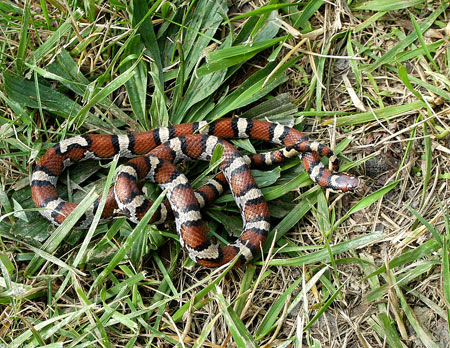
Photo of Eastern Milksnake courtesy of John White
Coastal Plain Milksnakes are now considered a color morph of the Eastern Milksnake (see below for more information) |
Size:
24 inches – 36 inches. Record: 52 inches. |
Appearance:- This slender snake has a ground color of tan to light brown with 32 or more broad red with black-bordered blotches down the body in three or five rows.
- At the nape of the neck, there is a grey or tan Y-, V-, U, or A- shaped patch.
- The belly has a black-and-white checkerboard pattern.
- Scales are not keeled.
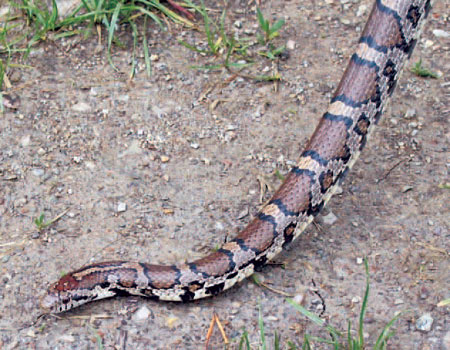
Close-up Photo of Eastern Milksnake courtesy of Scott A. Smith
|
Habitats:Will utilize a variety of habitats. In higher elevations may be found in deciduous and mixed forests, grassy hillsides, and rocky outcrops. In lower elevations, they prefer wooded areas, open fields, powerline rights-of-way, and around human habitation.

Photo of Habitat for Eastern Milksnake courtesy of Rebecca Chalmers
|
How to Find:Primarily nocturnal and burrowing so may be difficult to find. This snake may be found during the day under rocks, logs or boards or other cover. Known for showing up around barns and out buildings when mice are plentiful. Non-venomous. |
Distribution in Maryland:Found from the Fall Line (roughly I-95) west through the Piedmont and mountain regions.

Coastal Plain Milksnake

Size:
24 - 36 inches. Record - 52 inches.
Appearance: - Arguably our prettiest snake, specimens exhibit a wide variety of patterns and colors.
- Diagnostic features include:
- a light neck collar and
- the typically reddish blotches bordered in black which occur on the back reach the belly scales on the forepart of the body, but do not continue across the entire belly (like in the Scarlet Kingsnake).
- Scales not keeled.
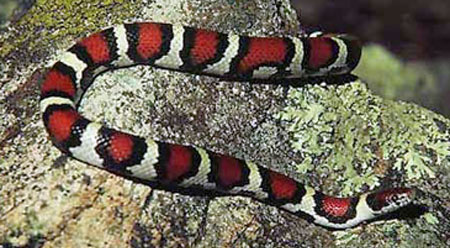
Coastal Plain Milksnake Photo courtesy of Corey Wickliffe
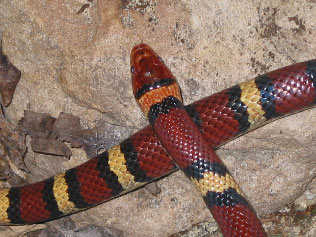
Close-up Photo of Coastal Plain Milksnake courtesy of John White
Habitat:
Little is known about how this snake’s habitat preferences differ from the species from which it derives. Specimens have been found in agricultural fields near woodlands and in open pine and mixed hardwood-pine forests, typically with sandy soils. Primarily found on the coastal plain, with the largest known populations in St. Mary’s and Calvert counties.
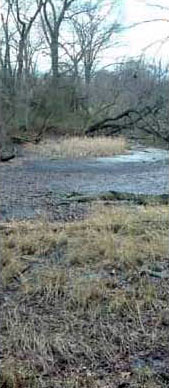
Habitat photo for Coastal Plain Milksnake courtesy of Rebecca Chalmers
How to Find:
Look under coarse woody debris in open mixed woods and on the edges of woods and agricultural fields. This snake is non-venomous. There is considerable individual variation on whether they will bite when handled.
Distribution in Maryland
Found only on the Coastal Plain.
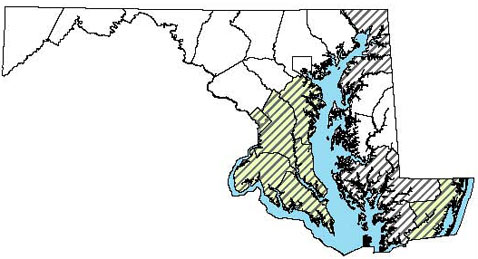
Scientific and common names follow Crother 2017.
Citation:
Crother, B. I. (ed.). 2017. Scientific and Standard English Names of Amphibians and Reptiles of North America North of Mexico, with Comments Regarding Confidence in Our Understanding pp. 1–102. SSAR Herpetological Circular 43.
https://ssarherps.org/wp-content/uploads/2017/10/8th-Ed-2017-Scientific-and-Standard-English-Names.pdf
|
|
